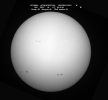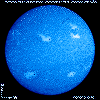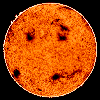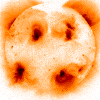







What differences and similarities do you notice between the different images? (If you click on each image you will get a larger version.) Not all of these images were taken at EXACTLY the same time. The Sun's rotation causes features to move across the Sun which can be seen in images taken at different times.
You might have noticed that the sunspots in the whitelight image are in approximately the same place on the Sun as the intense magnetic regions in the Calcium image. The dense gaseous regions which appear dark in through the Helium filter also occur in this general area as do the bright active regions in the Xray image. Remember that each image is a picture of a different layer in the sun. Some layers are higher up in the Sun's atmosphere than others.
Here again we see how different filters can be helpful to scientists. In addition to those seen here there are many other filters available for solar scientist to help them study the Sun. If you are interested in studying the magnetic field in the Sun you would want to include a Calcium image and perhaps an X-ray image which shows some magnetic loop structure. If you are interested in the way the density of the atmospheric gas varies around the disk of the Sun you would study a Helium image.
The use of filters allows us to study one or two factors at a time without being distracted by too much information. Later, by considering all the information together we can then paint a representative picture of the Sun or whatever object we happen to be studying.